
- •Unit 1 computer applications
- •Computers
- •What can computers do?
- •Unit 2 computer essentials
- •What is a computer?
- •Unit 3 inside the system
- •What’s inside a pc system?
- •Structure of the processor
- •Unit 4 bits and bites
- •Units of memory
- •Unit 5 magnetic drives
- •Technical details
- •Unit 6 optical breakthrough
- •Optical disks and drives
- •Iomega's removable drives
- •Unit 7 input / output devices
- •Voice recording device h. Keyboard
- •Unit 8 capture your favourite image
- •Vivid easy-to-use faster fashionable wide shots
- •Unit 9 viewing the output
- •The monitor
- •Unit 10 choosing a printer
- •Types of printers
- •Unit 11 operating systems Exercise 1.Look at the diagram below. What is the function of the operating system?
- •Exercise 4. Language work
- •Unit 12 the graphical user interface
- •Unit 13 a walk through word processing
- •Word-processing facilities
- •Unit 14 spreadsheets
- •Unit 15 databases
- •Basic features of database programs
- •Exercise 6. Writing
- •Unit 16 faces of the internet
- •Exercise 2. Maybe we can find it on the Internet.
- •Exercise 3. Reading.
- •Internet software
- •Irc, audio and video chatting
- •MIrc for Windows is a typical Internet relay chat program. You can get it at http://www.Mirc.Co.Uk/
- •Unit 17 programming and languages
- •Programs and programming languages
- •Exercise 3. These are answers to questions about the text. Write the questions.
- •Variables and the Declaration Statement
- •Unit 18 computer networks
- •Computer networks
- •Network configurations
- •4 Bus/Ethernet
- •Unit 19 computer viruses
- •How computer viruses work
- •Unit 20 computers in the office
- •Information systems
- •Using Computers
- •Information Technology (it)
- •Exercise 5. Link each statement (1-) with a purpose (a-j).
- •Exercise 6. Match the words from the box with their definitions.
- •The future? We’re virtually there!
Unit 3 inside the system
Exercise 1. Read the advertisement and translate the technical specifications into your own language.
|
|
Ulysses XT |
|
Exercise 2. Try to answer these questions.
What is the main function of a microprocessor?
What unit of frequency is used to measure processor speed?
What does 'RAM' stand for?
Exercise 3. Read the text below and then sentences after the text. Decide if the sentences are true (T) or false (F), and rewrite the false ones to make them true.
What’s inside a pc system?
The nerve centre of a PC is the central processing unit or CPU. This unit is built into a single microprocessor chip – an integrated circuit – which executes program instructions and supervises the computer's overall operation. The unit consists of three main parts:
the control unit, which examines the instructions in the user's program, interprets each instruction and causes the circuits and the rest of the components – disk drives, monitor, etc. – to be activated to execute the functions specified;
the arithmetic logic unit (ALU), which performs mathematical calculations (+, -, etc.) and logical operations (and, or, etc.);
the registers, which are high-speed units of memory used to store and control information. One of these registers is the program counter (PC) which keeps track of; the next instruction to be performed in the main memory. Another is the instruction register (IR) which holds the instruction that is currently being executed. (see picture below)
One area where microprocessors differ is in the amount of data – the number of bits – they can work with at a time. There are 16, 32 and 64-bit processors. The computer's internal architecture is evolving so quickly that the new 64-bit processors are able to address 4 billion times more information than a 32-bit system.
The programs and data which pass through the central processor must be loaded into the main memory (also called the internal memory) in order to be processed. Thus, when the user runs an application, the microprocessor looks for it on secondary storage devices (disks) and transfers a copy of the application into the RAM area. RAM (random access memory) is temporary, i.e. its information is lost when the computer is turned off. However, the ROM section (read only memory) is permanent and contains instructions needed by the processor.
Most of today's computers have internal expansion slots that allow users to install adapters or expansion boards. Popular adapters include high-resolution graphics boards, memory expansion boards, and internal modems.
The power and performance of a computer is so partly determined by the speed of its microprocessor. A clock provides pulses at fixed intervals to measure and synchronize circuits and units. The dock speed is measured in MHz (megahertz) or GHz (gigahertz) and refers to the frequency at which pulses are emitted. For example, a CPU running at 1,600 MHz (1,600 million cycles per second) will enable the computer to handle the most demanding applications.
|
Central processing unit (CPU)
|
Organisation of a simple computer T |
|
M Popular chips:
|
A RAM chip
The RAM capacity can sometimes be expanded by adding extra chips. These are usually contained in small circuit boards called single in-line memory modules (SIMMs). Modern Pentuim processors also accept dual in-line memory modules (DIMMs), which allow for a wider data path. |
True of false?
The CPU directs and coordinates the activities taking place within the computer system.
The arithmetic logic unit performs calculations on the data.
32-bit processors can handle more information than 64-bit processors.
A chip is an electronic device composed of silicon elements containing a set of integrated circuits.
RAM, ROM and secondary storage are the components of the main memory.
Information cannot be processed by the microprocessor if it is not loaded into the main memory.
'Permanent' storage of information is provided by RAM (random access memory).
The speed of the microprocessor is measured in gigahertz or megahertz. One GHz is equivalent to one thousand MHz. One MHz is equivalent to one million cycles per second.
Exercise 4. Read the text from Exercise 3 again. Define what the words in bold print refer to?
... which executes program instructions and supervises ...
... the instruction that is currently being executed,
... the amount of data - the number of bits – they can work with at a time,
... the microprocessor looks for it on ...
... its information is lost when the computer is turned off.
... expansion slots that allow users to install adapters or expansion boards.
Exercise 5. Use the information in the reading passage and the diagram to help you match the terms below with the appropriate explanation or definition.
A processor consists of many different electronic circuits and devices for performing control functions, arithmetic and logic operations, and data transfers. Data may be transferred from backing storage to the internal memory or from the internal memory to the arithmetic unit by means of conductive channels known as buses. The part of the processor which controls data transfers between the various input and output devices is called the control unit.
m
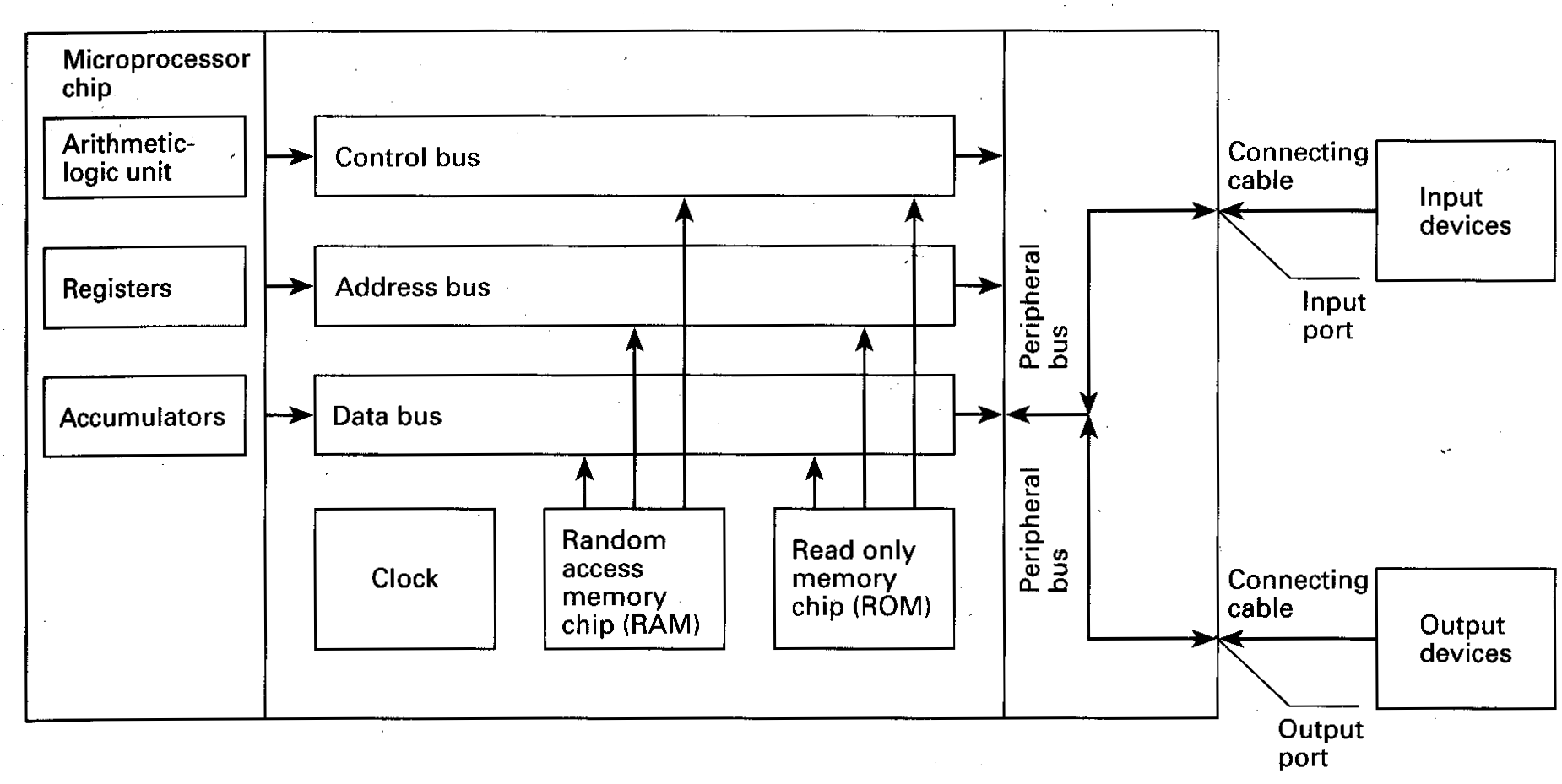 icroprocessor
chip a used to send address details between the memory and the
address register
icroprocessor
chip a used to send address details between the memory and the
address registerregisters b consists of an arithmetic-logic unit, one or more working registers to store data being processed, and accumulators for storing the results of calculations
accumulators c a group of signal lines used to transmit data in parallel from one element of a computer to another
control bus d groups of bistable devices used to store information in a computer system for high-speed access
address bus e an electronic circuit, usually a quartz crystal, that generates electronic pulses at fixed time intervals to control the timing of all operations in the processor
data bus f used for storing part of the operating system and application software known as 'firmware'; can only be read; cannot be written to or altered in any way
clock g used to store numeric data during processing
RAM h a group of signal lines 'dedicated to the passing of control signals
ROM i used for the temporary storage of application programs and data; can be written to and read from
Exercise 6. Read this passage about the structure of the processor and fill in the gaps using the words from the box.
|
adaptor boards registers microprocessor clock conductive buses system board accumulators input or output devices |

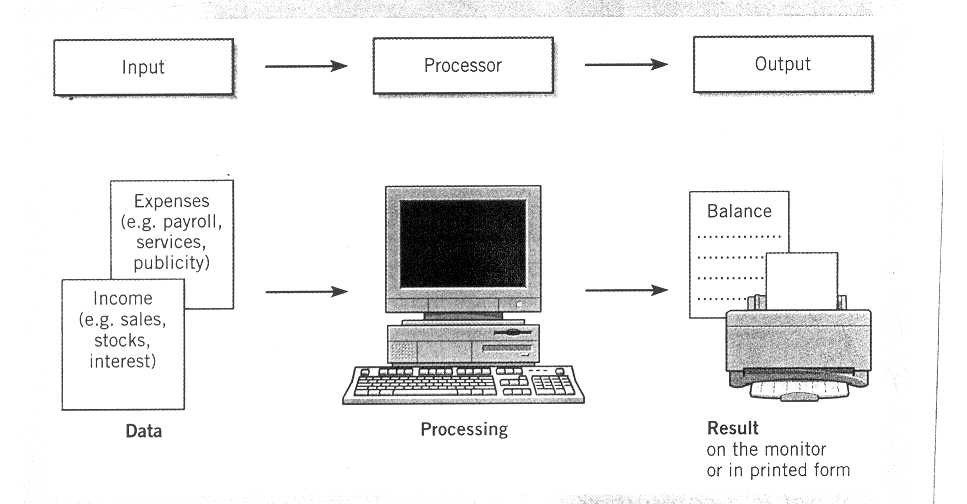
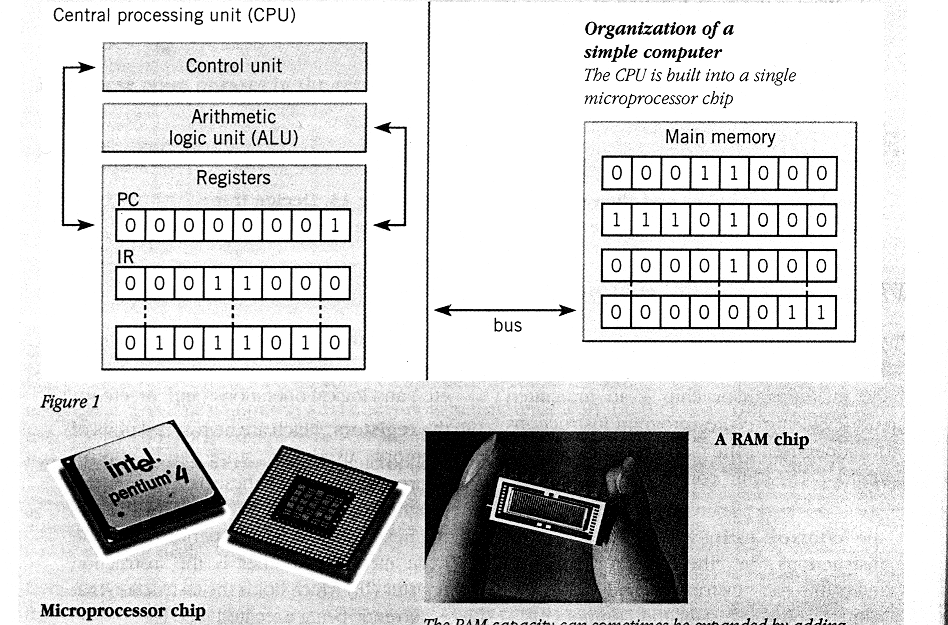
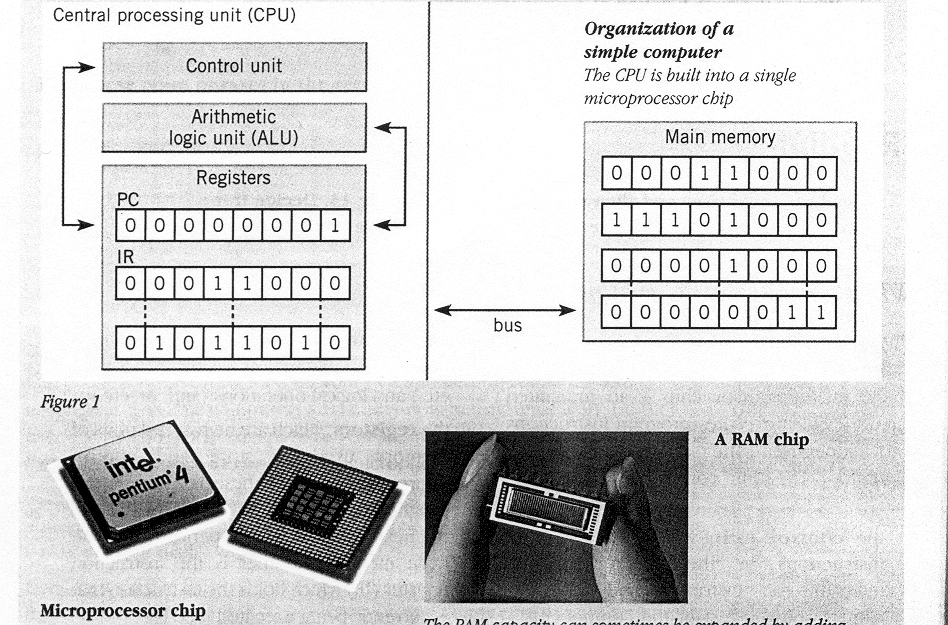 he
CPU is built into a single microprocessor chip
he
CPU is built into a single microprocessor chip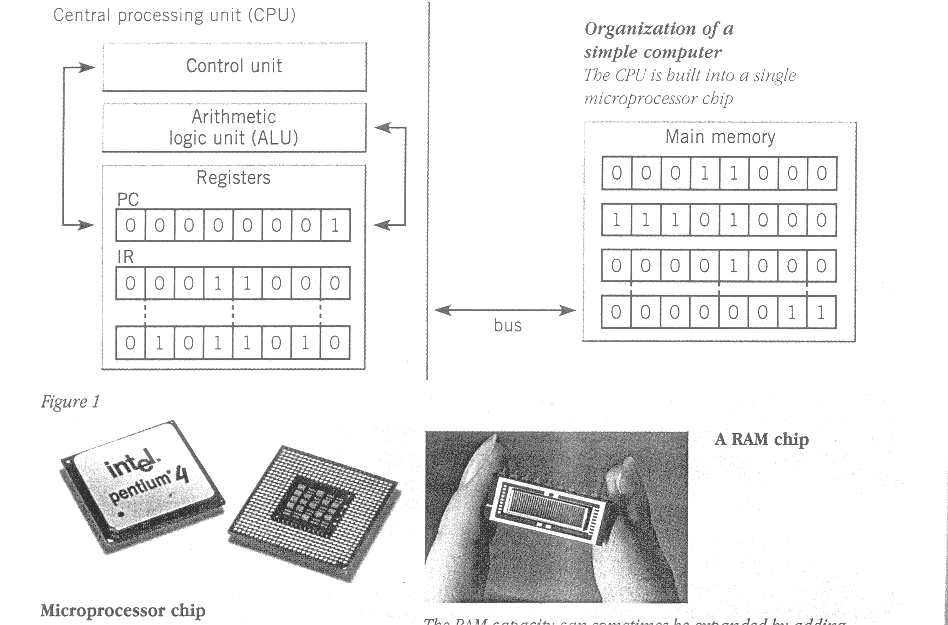 icroprocessor
chip
icroprocessor
chip